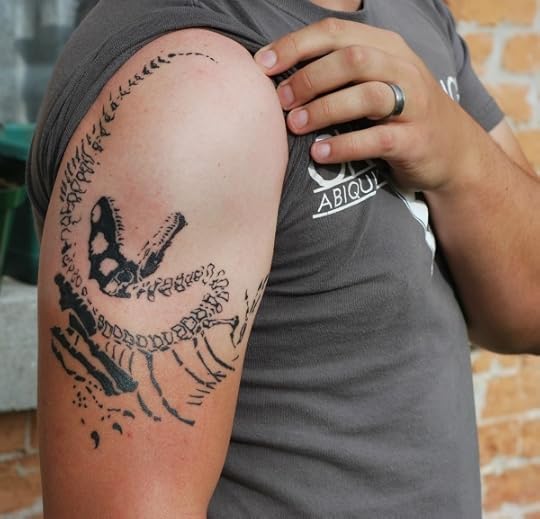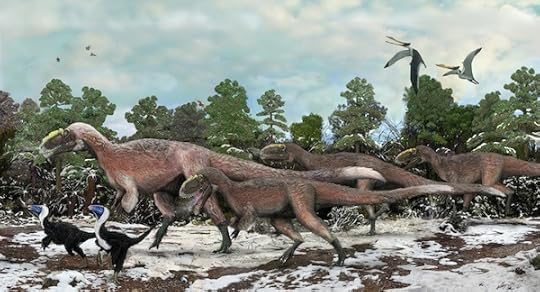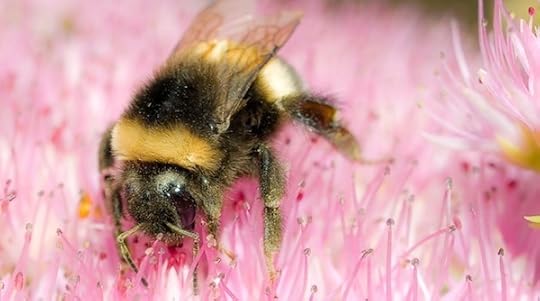Carl Zimmer's Blog, page 46
April 4, 2012
The One-Ton Turkey: Further Adventures in Slow-Cooked Science
One smoggy afternoon in the summer of 2010, I took a walk down Xi Zhi Men Wai Avenue in Bejing. The ten-lane thoroughfare was packed with cars, buses, pedalos, and bicycles. But even here, in China's hyperurbanized core, there were birds to keep me company. Sparrows shot around the roadside trees. Black and white magpies perched in the treetops, issuing their rattling calls. I was walking down Xi Zhi Men Wai Avenue to pay a visit to a museum, where I could take a close look at the fossilized remains of some ancient cousins to the magpies. I was going to see some feathered dinosaurs.
 Feathers are one of the marvels of animal evolution–a combination of extreme beauty and extreme usefulness–but for over a century their fossil record stopped with the 145-million-year-old Archaeopteryx. It was a mix of bird anatomy such as wings and older vestiges of a reptilian origins, such as teeth and a long, bony tail. But in the past 20 years, paleontologists have found a series of spectacular fossils of dinosaurs with traces of ...
Feathers are one of the marvels of animal evolution–a combination of extreme beauty and extreme usefulness–but for over a century their fossil record stopped with the 145-million-year-old Archaeopteryx. It was a mix of bird anatomy such as wings and older vestiges of a reptilian origins, such as teeth and a long, bony tail. But in the past 20 years, paleontologists have found a series of spectacular fossils of dinosaurs with traces of ...

April 3, 2012
The Genome Beat, Or Curing My Case of Yet-Another-Genome Syndrome
On March 20, I delivered a keynote talk at the Joint Genome Institute annual meeting. I talked about my experience of reporting on genomes over the past two decades–from my initial awe at the very first sequenced genomes to weary fatigue as thousands of genomes were published, and to a recognition of what the real news is about genomes today. Here's the video.

April 1, 2012
Tomorrow's brain debate: simulcast and livestream update #brainbrawl
 Tomorrow (April 2) Robert Krulwich of Radiolab and I will be at Columbia University to moderate a debate about the future of neuroscience. Entitled, "Does the brain's wiring make us who we are?" it will bring together Sebastian Seung of MIT and Anthony Movshon of NYU.
Tomorrow (April 2) Robert Krulwich of Radiolab and I will be at Columbia University to moderate a debate about the future of neuroscience. Entitled, "Does the brain's wiring make us who we are?" it will bring together Sebastian Seung of MIT and Anthony Movshon of NYU.
The auditorium filled up less than two hours after the tickets were made available online a few weeks ago, and a hefty waiting list quickly took shape. Fortunately, the organizers have made it possible for more people to watch the neurological fireworks. If you'd like to see a live simulcast, you can sign up for a free seat in nearby Pupin Hall 301. Here's the Eventbrite page where you can grab yours.
If you can't make it there in person, you can join us in cyberspace by catching the livestream on the Radiolab web site.
And if you want to tweet the debate or follow it on Twitter, please use the hashtag #brainbrawl (I decided #igotyourconnectomerighthere would take up too much space…)
If you'd like get ready for the debate by reading about its origins, here are some places to start:
*My latest Discover brain column is about Seung's ...

March 31, 2012
The Mysteries of the Dinosaur Tattoo
 Brian Switek writes,
Brian Switek writes,
I have an Allosaurus on my arm. Heart of Gold Tattoo artist Jon McAffee put it there a few weeks ago. I think the tattoo—designed for me by friend and artist Glendon Mellow—came out beautifully. Contorted into the classic dinosaur death pose, the Jurassic apex predator is an expression of my passions and aspirations.
Paleontologists have uncovered scores of fascinating dinosaurs. I would have been proud to carry almost any dinosaur on my sleeve. But I knew my first science ink had to be Allosaurus. The dinosaur is not only the state fossil of Utah—I moved to the beehive state last year to get closer to dinosaurs—but the familiar predator is also an enigma.
Around 150 million years ago, when Allosaurus stalked across Jurassic Utah, the fern-covered landscape boasted an astounding diversity of huge dinosaurs. This was the time of giants such as Apatosaurus, Camarasaurus, Diplodocus, Brachiosaurus, Barosaurus and Stegosaurus, and these dinosaurs were prey for nightmarish carnivores such as Torvosaurus, Ceratosaurus and, of course, Allosaurus. There was scarcely a more fantastic time in the Age of Dinosaurs. But not all ...
March 30, 2012
Declining Bees and Toxic Insecticides: Sources for A Complex Story
Earlier this week, my editor at the New York Times asked if I'd write a story about a pair of new papers in Science detailing experiments on how insecticides affect bees. Bees have been in decline in many places, and scientists have been trying to figure out the cause–or causes–of their fall. These two new experiments represent a new wave of more realistic tests, taking place on farms instead of in labs. They're also important because they were designed to look at what happens when bees are exposed to more realistic, sublethal doses. My story appears in today's issue.
I found this story to be especially challenging to sum up in a single nut graph. To begin with, these experiments came after many years of previous experiments and surveys, which often provide conflicting pictures of what's going on with insecticides and bees. The experiments themselves were not–could not–be perfect replicas of reality, and so I needed to talk to other scientists about how narrow that margin was. As they should, the scientists probed deep, pointing out flaws and ambiguity–in many cases even as ...

March 23, 2012
A Smithsonian Q & A with E. O. Wilson: complete with outtakes
Smithsonian recently asked me to interview Harvard biologist E.O. Wilson about his new book, The Social Conquest of Earth. You can read the Q & A on their web site.
Wilson and I spoke for quite a while, covering wide range of subjects. One particularly interest part of the talk addressed his ongoing attack on a major aspect of modern evolutionary theory, known as inclusive fitness. I reported on his attacks–and the response of his critics–in the New York Times in 2010.
Basically, most evolutionary biologists believe that a great deal of behavior–including altruistic behavior–can be explained by the way genes get passed down among relatives. If you help your cousins, some of your genes will get transmitted even if you have no kids of your own. Wilson and his colleagues at Harvard, Martin Nowak and Corina Tarnita, argue instead that inclusive fitness doesn't make mathematical sense and is unnecessary. Wilson holds that good old natural selection on individuals can explain a lot, and he also argues for selection on higher levels. Groups of organisms–human tribes, for example–can be selected for their group-level traits.
In ...

March 21, 2012
Mapping 100 Trillion Connections: My new brain column for Discover
[image error]Our 80 billion neurons form an estimated 100 trillion connections. Through those links surge the signals that make thought possible. Sebastian Seung of MIT has been calling for a full-blown atlas of those connections, because he believes it will help us understand how the brain works and how the brain makes us who we are. In the April issue of Discover, I pay a visit to Seung's lab to see what he's up to, and what he hopes for the future. Check it out.
I couldn't be happier that this column is available a couple weeks before Seung will participate in a public debate about the connectome on April 2, hosted by myself and Robert Krulwich of Radiolab. The tickets were all snapped up about an hour and a half after becoming available online, but I will certainly report back afterwards about how it went.

March 19, 2012
Waiting for the Penicillin Moment: my new feature on antiviral drugs for Wired
On my way to give a keynote talk at a genome meeting in California, I noticed in the Hartford airport that the April issue of Wired is on the newsstand. And in that issue is a feature I wrote about fighting viruses, based on visits and interviews with scientists exploring new ways of doing battle with these invisible foes. It's not yet on Wired's web site yet (I'll post a link when it goes online), but here's the introduction for a taste:
There's a moment in the history of medicine that's so cinematic it's a wonder no one has put it in a movie. The scene is a London laboratory. The year is 1928. Alexander Fleming, a British microbiologist, is back from a vacation and is cleaning up his workspace. He notices that a speck of mold has invaded one of his cultures of Staphylococcus bacteria. It isn't just spreading through the culture, though. It is killing the bacteria surrounding it.
Fleming rescued the culture and carefully isolated the mold. He ran a series of experiments that confirmed it made a Staphylococcus-killing molecule. And Fleming then discovered it could kill many other species of infectious bacteria as ...

March 17, 2012
Gutenberg, the Solar System, and Biological Cities: New Reviews at Download the Universe
 Here's the latest batch of reviews from Download the Universe. Check out these science ebooks:
Here's the latest batch of reviews from Download the Universe. Check out these science ebooks:
Living Architecture: How Synthetic Biology Can Remake Our Cities: A contemplation of how tinkering with cells can change civilization.
The Solar System: An interactive guide to the planets.
Gutenberg the Geek: How the explosion of the Internet today mirrors the birth of movable type.
Natural History: Mammals – Carnivores: Lions and tigers and bears, oh my!
The Stir of Waters: Radiation, Risk, and the Radon Spa of Jáchymov. A journey to a bizarre resort where people bathe in radioactive waters.

March 16, 2012
Animal Friendships on the Faith Middleton Show
This week on Connecticut Public Radio I had a great talk with Faith Middleton about my recent Time magazine story about animal friendships. You can listen to the episode here. (I show up at about 33:00.)

























